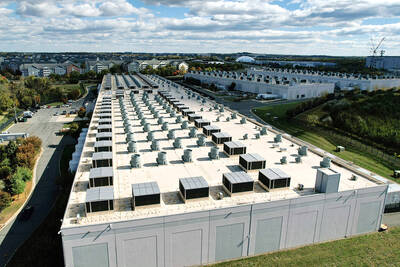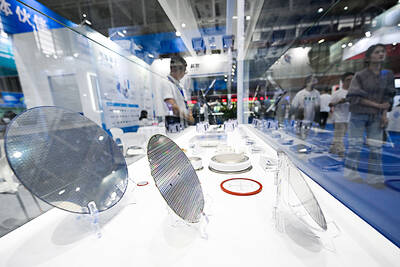The semiconductor sector is expected to benefit from the growth of wearable devices in the next few years, SinoPac Securities Investment Service (永豐投顧) said in a report on Tuesday.
Wearable devices are electronic gadgets that combine computing technology and built-in mobile Internet access with embedded sensors that can respond to the wearer’s movements.
As a result, the availability of various sensors will trigger demand of microelectromechanical systems (MEMS), thereby boosting the proportion of semiconductor components in such devices, SinoPac said.
In October last year, Gartner Inc said MEMS sensors and microcontroller units such as gyroscopes, accelerometers, electronic compasses and pressure sensors would become popular in mobile devices over the next few years, making them one of the major drivers of the global semiconductor industry.
While wearable devices have yet to mature or become a trend, analysts say more smart bracelets, watches and other products are likely to emerge in the next two years to drive growth in the wearable device segment, following in the footsteps of Google Glass, Samsung’s Galaxy Gear smartwatch and Nike’s FuelBand bracelet.
The Industrial Economics and Knowledge Research Center (IEK) has predicted the global market value of wearable devices could reach US$5.5 billion this year, up 83.3 percent from last year.
The figure is estimated to increase 72.7 percent to US$9.5 billion next year and expand another 68.4 percent to US$16 billion in 2016, the Taiwan-based researcher said. By 2018, the global market value of wearable devices is estimated to reach US$35 billion, it said.
Against this backdrop, the proportion of semiconductor components used in wearable devices is estimated to hit 18.3 percent in 2018 from 16.8 percent this year, SinoPac said in the report, citing IEK’s forecast.
The global market value of semiconductor components used in wearable devices will also expand at an annual composite growth rate of 53.2 percent to US$6.41 billion in 2018 from US$920 million this year, the report said.
SinoPac said companies in Taiwan’s semiconductor sector such as wafer foundries and chip packagers were likely to secure outsourcing orders from global integrated device manufacturers in the international MEMS supply chain.
Taiwan Semiconductor Manufacturing Co (台積電), the world’s largest contract chipmaker, Avanced Semiconductor Engineering Inc (ASE, 日月光), the world’s largest chip packaging and testing company, IC testing service provider King Yuan Electronics Co (京元電) and memorychip testing service firm Lingsen Precision Industries Ltd (菱生) are likely to enjoy technological and cost advantages over their domestic peers in the coming years, SinoPac said.
Shares of TSMC closed out the year at NT$105.50 on Tuesday, up 8.76 percent for the whole of last year, while ASE finished the year up 9.92 percent at NT$27.7, according to the Taiwan Stock Exchange’s data. King Yuan rose 10.54 percent over the last 12 months at NT$20.45 and Lingsen moved up 6.6 percent to NT$16.15, the exchange’s data showed.

The demise of the coal industry left the US’ Appalachian region in tatters, with lost jobs, spoiled water and countless kilometers of abandoned underground mines. Now entrepreneurs are eyeing the rural region with ambitious visions to rebuild its economy by converting old mines into solar power systems and data centers that could help fuel the increasing power demands of the artificial intelligence (AI) boom. One such project is underway by a non-profit team calling itself Energy DELTA (Discovery, Education, Learning and Technology Accelerator) Lab, which is looking to develop energy sources on about 26,305 hectares of old coal land in

Taiwan’s exports soared 56 percent year-on-year to an all-time high of US$64.05 billion last month, propelled by surging global demand for artificial intelligence (AI), high-performance computing and cloud service infrastructure, the Ministry of Finance said yesterday. Department of Statistics Director-General Beatrice Tsai (蔡美娜) called the figure an unexpected upside surprise, citing a wave of technology orders from overseas customers alongside the usual year-end shopping season for technology products. Growth is likely to remain strong this month, she said, projecting a 40 percent to 45 percent expansion on an annual basis. The outperformance could prompt the Directorate-General of Budget, Accounting and

Netflix on Friday faced fierce criticism over its blockbuster deal to acquire Warner Bros Discovery. The streaming giant is already viewed as a pariah in some Hollywood circles, largely due to its reluctance to release content in theaters and its disruption of traditional industry practices. As Netflix emerged as the likely winning bidder for Warner Bros — the studio behind Casablanca, the Harry Potter movies and Friends — Hollywood’s elite launched an aggressive campaign against the acquisition. Titanic director James Cameron called the buyout a “disaster,” while a group of prominent producers are lobbying US Congress to oppose the deal,

Two Chinese chipmakers are attracting strong retail investor demand, buoyed by industry peer Moore Threads Technology Co’s (摩爾線程) stellar debut. The retail portion of MetaX Integrated Circuits (Shanghai) Co’s (上海沐曦) upcoming initial public offering (IPO) was 2,986 times oversubscribed on Friday, according to a filing. Meanwhile, Beijing Onmicro Electronics Co (北京昂瑞微), which makes radio frequency chips, was 2,899 times oversubscribed on Friday, its filing showed. The bids coincided with Moore Threads’ trading debut, which surged 425 percent on Friday after raising 8 billion yuan (US$1.13 billion) on bets that the company could emerge as a viable local competitor to Nvidia